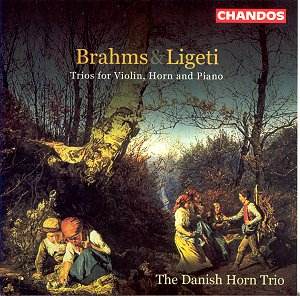Brahms's Horn Trio is rightly positioned in the central
repertory of chamber music, despite its unusual instrumental combination.
Other composers who have chosen to adopt the same scoring have done
so in full knowledge that the Brahms piece forms a point of reference.
Ligeti was only too happy to follow this line when
he composed his trio in 1982; not that the music sounds very Brahmsian
- Ligeti is not the kind of composer to opt for mere pastiche - but
the balancing and blending of the instruments does follow Brahms's preference
for sane, beautifully sonorous developments. Perhaps it was composed
as an antidote the intensely controversial opera Le grand macabre. The
Trio is notable for its mellifluous tone, although of course there is
no lack of challenge either, with subtle and telling clashes between
the individual instrumental lines.
The significant part of the Ligeti Trio is surely the
final movement, an Adagio lament, full of dark intensity, and perhaps
therefore related to the Adagio mesto of the Brahms third movement ('mesto'
means sad). Slow tempi offer many technical challenges to this particular
instrumental combination, but the Danish Horn Trio - Christina Østrand
(violin), Jakob Keiding (horn), Per Salo (piano) - triumph over all
the obstacles, with a display of true virtuosity that makes the performances
sound the most natural thing in the world. They are beautifully atmospheric
in the slow music of both works.
The Brahms Trio is delivered with well chosen gradings
of phrasing and tempo, suiting the sounds of the ensemble and bringing
out its expressive trends and developmental lines. This is a most distinguished
issue, and all praise to Chandos for sanctioning this imaginative combination
of composers.
Terry Barfoot


